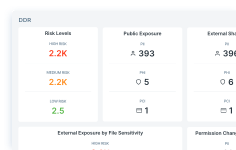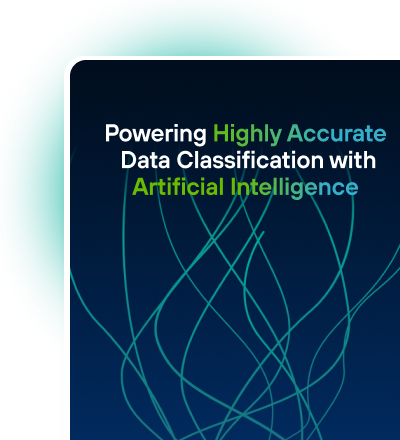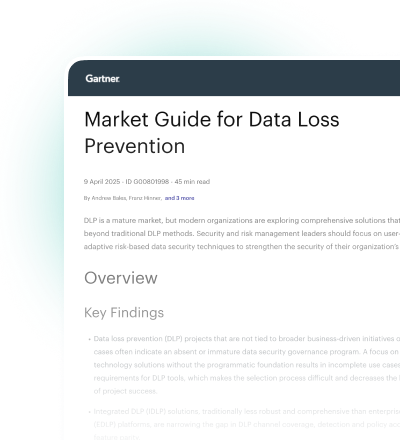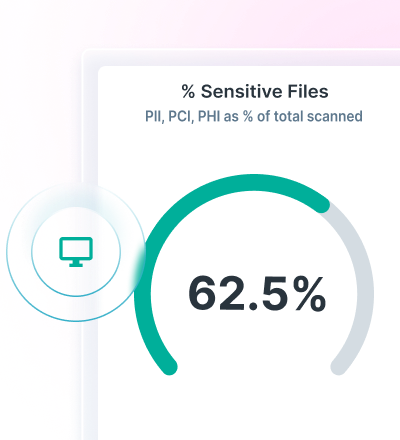What is Data Security Posture Management (DSPM)? A Guide for 2025
Data Security Posture Management (DSPM) is a security solution that enables enterprises to discover and classify structured and unstructured data across file storage locations, such as cloud applications or on-premises. It also helps to proactively address incident remediation.

How Do DSPM Solutions Work?
Structured and unstructured data is littered across Software-as-a-Service (SaaS) applications, Infrastructure-as-a-Service (IaaS) locations and on-premises storage, making it difficult to get a handle on where the most important and sensitive information is. DSPM provides the visibility and controls needed to secure this complex environment.
How Does DSPM Software’s Data Discovery Capabilities Work?
DSPM continuously discovers data across cloud, network and on-premises storage to uncover and catalog every piece of data your organization has.
Finding sensitive data is the crucial first step in protecting it. DSPM solutions scan your entire data ecosystem such as:
- Cloud platforms (AWS, Azure, GCP)
- SaaS applications (Microsoft 365, Salesforce)
- On-premises storage and databases
Modern DSPM software maintains continuous visibility as data moves and changes through built-in functionality or solution integrations.
What Data Classification and Risk Assessment Abilities Does a DSPM Solution Provide?
Once discovered, data must be categorized and evaluated for risk exposure. Modern DSPM solutions typically employ advanced AI-driven techniques in this critical phase:
- AI detectors identify regulated information (SSNs, credit cards, health records) and proprietary data using sophisticated recognition capabilities that surpass traditional pattern matching approaches
- AI summarizers analyze contextual signals like location, access patterns, user behavior, and business relevance to understand data meaning and usage
- Rich classification assignment provides comprehensive data insights that extend well beyond basic Public/Internal/Confidential/Restricted labels, delivering detailed information about file content, business context, regulatory implications, and specific risk factors
These advanced classifications are then combined with protection controls, access permissions, and compliance requirements to generate dynamic risk scores.
AI-powered classification has become baseline functionality for usable DSPM platforms, with modern solutions leveraging multiple AI types working together including GenAI, deep neural network classifiers, and specialized detection engines to continuously improve both classification accuracy and risk assessment.

How Does a DSPM Platform Help Organizations Manage and Remediate Risk?
Identifying issues without resolution creates little value. Modern DSPM platforms bridge this gap with customizable controls that adapt to your organization's unique needs and challenges.
These controls include permissions management to implement the Principle of Least Privilege (PoLP), ensuring users only access files required for their tasks and addressing over-permissioned or publicly accessible data.
Additional capabilities include data mapping to properly categorize sensitive information, mislocated data remediation to address files stored in inappropriate repositories, and data archiving/deletion workflows for managing at-risk files past retention periods or classified as ROT (redundant, obsolete, trivial).
The best solutions allow for custom rules that align with your specific security policies and regulatory requirements. DSPM shifts security teams towards proactive risk management, systematically reducing data exposure before it leads to breaches.
How Does Reporting and Analytics Work Within DSPM Software?
DSPM solutions include reporting and analytics tools that provide visibility into an organization's overall data security status.
These reporting capabilities typically feature dashboards showing where sensitive data exists across environments, highlighting specific risk factors such as ROT (redundant, obsolete, trivial) data, over-permissioned files, mislocated information, and duplicated content.
Security teams can use these insights to track metrics over time and prioritize remediation efforts where they'll have the greatest impact.

What Are the Different Ways You Can Deploy a DSPM Solution?
DSPM solutions offer flexible implementation options:
- Cloud-native SaaS for rapid deployment
- Hybrid models for sensitive environments
- On-premises for control over data sovereignty
- Agentless architectures to minimize overhead
Most enterprises start with their most critical data repositories and expand coverage incrementally.
Uncover Hidden Data Risk in Minutes
How Does AI and Automation Enhance Data Security Posture Management?
This is a post-ChatGPT world; where does artificial intelligence enhance the effectiveness of DSPM solutions?
Enterprises are responsible for petabytes of customer information and proprietary data. Knowing exactly where each byte is, its risk level and what that means to the business is a fool's errand when relying solely on manual processes.
Automation enables continuous, large-scale data discovery and scanning across enterprise environments. Organizations can now automatically classify data in real-time as it's created, moved, or modified—eliminating the delays and gaps inherent in manual reviews.
Artificial intelligence's primary value lies in delivering highly accurate data classification while dramatically reducing false positives. AI brings the precision needed to confidently distinguish between truly sensitive data and benign information that might trigger traditional rule-based systems.
For DSPM solutions to confidently incorporate these capabilities, modern solutions must handle a wide range of file types, from PDFs to video, as well as understand an even broader array of data fields to assign correct classifications and adjust for compliance requirements. This includes leveraging GenAI capabilities, deep neural network classifiers, and other predictive AI technologies working together.
Forcepoint DSPM runs on AI Mesh, which powers highly accurate data classification. More specifically, AI Mesh is a highly networked classification architecture that uses GenAI, deep neural network classifiers, light AI classifiers and other predictive AI and data science capabilities to deliver more rapid, accurate and efficient data classification.
What are the Key Benefits Organizations Can Expect from Implementing a DSPM Platform?
The benefits of Data Security Posture Management can boil down to four outcomes.
Increase Productivity: DSPM makes data access and sharing more reliable and secure, resulting in better innovation and collaboration across the workforce. Also, administrators get time back from fewer false-positive alerts and through automating data discovery and classification.
Cut Costs: Automation enables enterprises to cut down the time and resources spent on investigations and remediation, without compromising on their data security. Similarly, a stronger security posture reaps dividends in not having to deal with the financial implications of a data breach or non-compliance penalty.
Reduce Risk: DSPM safeguards sensitive information to stop data breaches and leaks, thereby reducing risk across the enterprise. Furthermore, it finds data that was not properly categorized – or potentially even known about – to ensure dark data does not result in a security incident.
Streamline Compliance: For example, Forcepoint DSPM generates reports that demonstrate compliance with data privacy regulations, saving security teams' time and resources during audits. By providing a centralized view of data, it also makes it easier to implement and enforce data governance policies.
How does DSPM Integrate With Other Security Technologies?
DSPM rarely operates in isolation. Most organizations integrate it with complementary security technologies to create a comprehensive data protection strategy. The insights DSPM software provides about data location, sensitivity, and risk naturally enhance other security tools:
Data Detection and Response (DDR) continuously monitors data usage, detecting and responding to potential breach threats in real-time. While DSPM provides visibility into data at rest, DDR focuses on data in use - creating complete protection across the data lifecycle when used together.
Data Loss Prevention (DLP) enforces policies governing how users interact with sensitive information. DSPM's discovery and classification capabilities ensure DLP policies target the right data with appropriate controls.
Cloud Access Security Broker (CASB) secures data in cloud applications. DSPM feeds CASBs critical context about what data requires protection and appropriate access levels.
Identity and Access Management (IAM) systems benefit from DSPM's visibility into what sensitive data users can access, enabling more precise privilege management.
Cloud Security Posture Management (CSPM) focuses on cloud infrastructure configuration. While CSPM secures the environment, DSPM protects the actual data within it - creating comprehensive cloud protection when used together.
These integrations create a data-centric security ecosystem where tools share context and coordinate responses, significantly improving overall protection effectiveness.
Realistic DSPM Use Cases
How Can Healthcare Organizations Use DSPM to Secure Patient Data?
Healthcare providers often face challenges securing patient information as they expand digital transformation initiatives. Legacy tools may provide limited visibility into data outside traditional medical record systems.
DSPM can reveal protected health information residing in unexpected locations - from development environments to collaboration platforms. The classification capabilities help identify sensitive records even when they lack obvious identifiers.
By connecting these insights with existing security tools, organizations can create unified protection across all patient data, preventing potential breaches while streamlining HIPAA compliance efforts.
How Can Financial Services Institutions Use DSPM to Comply with Regulations?
Financial institutions typically struggle with regulatory requirements across multiple jurisdictions. Manual data discovery processes can consume thousands of analyst hours while leaving potential exposures.
With DSPM implementation, organizations can automatically discover and classify sensitive data across hybrid environments. A solution might identify numerous files containing unencrypted financial information outside approved repositories, including in shadow IT systems.
Using risk prioritization capabilities, security teams can significantly reduce sensitive data exposure while cutting compliance preparation time delivering both improved security and operational efficiency.
DSPM FAQs
How does DSPM differ from legacy data classification tools?
Unlike traditional tools that work with known data repositories using predefined rules, DSPM continuously discovers both known and unknown data across environments, leveraging AI for more accurate classification and providing context about access patterns and security controls.
What organizational roles should be involved in DSPM implementation?
Because successful DSPM deployment requires collaboration beyond security teams, many organizations establish a data risk committee to regularly review DSPM insights and coordinate remediation efforts. This could include IT infrastructure managers, data governance specialists, compliance officers, and business unit representatives who understand departmental data value.
How can organizations measure DSPM ROI beyond compliance?
You can track metrics such as reduction in sensitive data exposure (attack surface reduction), time savings in data discovery processes, improvements in mean-time-to-remediate incidents, and reductions in storage costs from eliminating redundant or obsolete data.
Forcepoint DSPM: A Security Solution from an Industry Leader
Forcepoint DSPM provides comprehensive data discovery, classification and remediation of risky data. It integrates seamlessly with Forcepoint DDR, DLP, and CASB solutions to protect data throughout its lifecycle while simplifying management through a unified security approach built on decades of data protection expertise.








